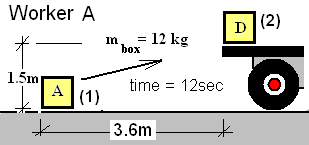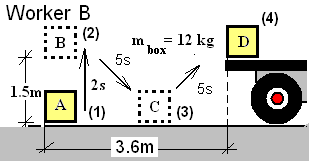| THERMO Spoken Here! ~ J. Pohl © | TOC NEXT ~ 127 |
Workers A and B
Two events are analyzed with approximation.
Basic mechanics can be used with the energy equation to evaluate the efficacies of work tasks. Consider the manners by which each of two workers moves a BOX (m = 12kg) kilograms from the storage floor to the tailgate of a truck. Use the data of the figures.

Calculate:
i) the energy expended (J), and
ii) the average power (W), for the moving events of A and B as described below.
Worker A:
From the floor (1), the BOX is lifted waist-high, then carried and placed on truck tailgate (2).
? We select a BOX as our system. We model it as an EXTENDED BODY. We write the rate form of the energy equation:

| (1)
In writing the energy equation, we anticipate zero change of internal energy of the BOX. |
Next separate variables and apply the integration operators ( ?). The limits are the time of initiation (call that time "0+") and a second time, an increment of time later, t = t + ?t = 0 + ?t.

| (2)
The integration operator (with limits) is applied. |
The energies, left-of-equality, integrate directly since the integrand is unity (one or "1"). Mathematics calls differentials of integrals having "1" as the integrand, Exact differentials.
To integrate the work-rate, (right-of-equality) will require some thought. The summation (S) reminds us to identify all applicable manners of work of the event. There are two forces that act on the BOX. The first and larger is the force applied by the person who moves it. A second force is the force of drag, the force of resistance exerted by the surrounding air as the BOX moves through it.
Notice since we use the perspective, potential energy, our system is in fact the BOX and Earth. Consequently the gravity force is not considered - it's effect is potential energy change. With these considerations our equation becomes (3):

| (3)
Left of equality, Eqn-2, integrates to become increments of energy. |
Equations (1), (2) and (3), express work rate not as W but as W(t). This makes the point that the work-rate of the mover (A or B) might vary over the duration of the event. Generally work is a function of time but given too little data, we cannot perform the integration. To proceed (to get some answer) we apply the Mean Value Theorem of Calculus to the work integral (3 - below).

| (4)
Can ΔKE be neglected? How large might it be? |
Of the three terms, term (3) is determined last (as the sum of terms (1) and (2)). Term (2) evaluates readily. It is simply the mass times gravity times the height of lift - (2) in Eqn-5.

| (5)
Below we estimate ΔKE. |
About the kinetic energy, a first thought might go like this. The Box velocity is initially zero. The worker picks it up then does work to give it some speed of motion (ΔKE > 0). But at the end of the event the BOX is slowed, does it "give" work back to the worker? For the event is ΔKE zero hence no contribution to the worker's average work rate? Nonsense!
The worker must apply effort to give the BOX speed (and that KE) but none of that effort is returned upon slowing of the box to a stop. So how can the contribution of ΔKE be approximated? Let's break the ΔKE into two pieces.

| (5) The kinetic energy could be very large. |
To write the kinetic energy term, KEmax, we require the maximum speed the worker gives to the BOX. Zero speed is the easiest but then the BOX would not be loaded. From the sketch we have the least distance the BOX must travel and the time required. The equation relating these is:

| (6) We can calculate the least average speed. |
The least distance the BOX is moved in 12 seconds is [(3.6m)2 + (1.5m)2]1/2 = 3.9 m. Thus the kinetic energy the BOX must attain (at its very least) is written in (7) as:

| (7) Least kinetic energy. |
When numbers are applied to (7) the least average power expended by Worker A is obtained:

| (8) Least average power of Worker A. |
#####################################
Next we investigate the task as done by Worker B. The image (below right)shows characteristics of the action as he moves a BOX onto the truck tailgate.

Excessive, disjointed motion is wasteful.
Worker B:
From the floor (1) needing 2 seconds the BOX is lifted waist-high (2). Carrying toward the truck requires 4 seconds but the BOX is dropped (3). Lifted again to waist-height, in 4 seconds, the BOX is placed on the tailgate.
The BOX location and properties, and event duration are the same as for Worker A. Results of that analysis can be used (with some thought).
We can use information of the second line of (8). Worker B lifts the BOX twice and he squanders its kinetic energy when he drops it. For Worker B we have:

| (9)
It is helpful NOT to rearrange the terms until the last step. |

Workers A and B
Two events are analyzed with approximation.
Basic mechanics can be used with the energy equation to evaluate the efficacies of work tasks. Consider the manners by which each of two workers moves a BOX (m = 12kg) from the storage floor to the tailgate of a truck. Use the data of the figures.
Calculate the energy expended (J), and the average power (W) for the moving events of A and B as described below.
Premise presently unwritted!